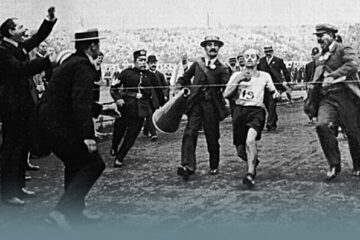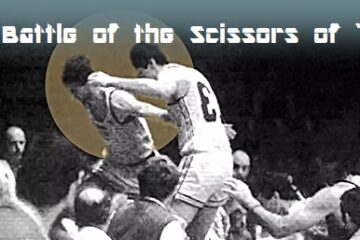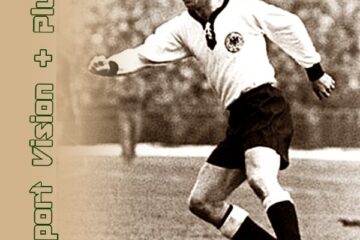History of champions | Rudolfo Volk, the striker who turned to be a keeper!
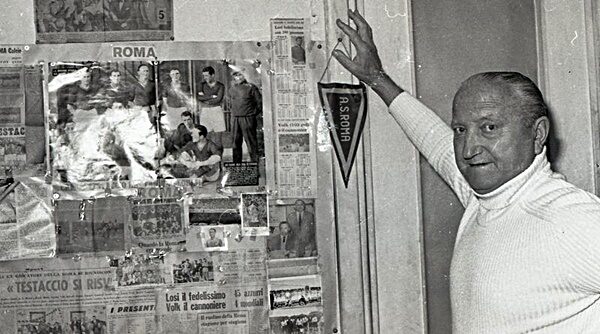
What we will say below is the sad story of a great champion without a past and without a future!
Rudolfo Volk!
Maybe few people know this name, although he was one of the best center forwards of the 30s. Mainly with the team of Rome, in which he will win a name, when he will score the first goal in the historic derby against Lazio, in the 1-0 victory for Roma. He will become the best scorer not only of Rome but also of Serie “A” of the 30s.
After World War II, he has to leave his Istria to live in a migrant camp in Tuscany for…… 10 years!!!
After leaving this camp, his teammate from Rome and his friend, one of the symbolic players of Italian football, Fulvio Bernardini, helps him start working as a keeper, but this time as a maintenance worker in a building.
I have never hidden myself as a supporter of the Rome football team, but also the history of this city in general, I am motivated to write the following about this champion, whose tragic life aroused my interest, and I hope it is as well for the readers of the Column “Histori of the champions” on this sports page.
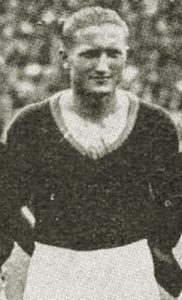
Rudolf Volk!
“Zigefrido”; “Forke”; “Sciabolone” are some of the nicknames that were called by the ardent fans of Rome. The Italian, born in Fiume on January 14, 1906, was mainly active with the clubs “Unione Sportiva Fiumiana (1927-1928) and “AS Roma” (1928-1933). His role in the field was center forward and he had a body length of about 1.86 m.
He was a legendary pre-war striker, a center forward with excellent scoring abilities. Very strong and heavy player with fantastic agility when he received the ball, usually with his back to the goal, he turned quickly and launched “a rocket” that no one could stop the ball into the net.
Volk had a very powerful shot and the ability to score from all positions, make quick and unexpected moves, but technically he was quite weak. The historical striker of Rome started his sports career taken by the current of life. Bought from Roma with Marcello Mihalich (who then returned to Napoli), he would quickly become one of the first idols of the “Testaccio” pitch, where he would also be the first to score the official and decisive goal in the first derby between Rome and Lacie, in 1929, the match which ended 1-0 for the formation of “testaccio”.
During the Fascist period, his surname was Italianized as “Folchi”, at the request of the regime, in addition, during his military service in Florence, he participated in the second (unofficial) competition in the history of Fiorentina, which took place in 1926 against “Sampierdarenese”. On that occasion, he used the nickname “Volteni” because recruits were forbidden to perform any activity outside of military service. The “giallorosso” player, especially appreciated by the public, was first nicknamed Siegfried, then quickly changed to the more Roman “Sigghefrido”. It was also called “Sciabbolone”, (a kind of long sword with a curved blade due to the trajectory it gave the ball) as opposed to “Sciaboletta”, the derogatory nickname given to King Vittorio Emanuele III (physically short and bent)!
He was later sold, first in Serie B to Pisa in c. 1934, due to internal quarrels with Guaita and Banchero and after one season in the ranks of Triestine in Serie A, he returned to Fiumana, his first team with whose shirt climbed to Serie B in 1940-41. After a career as a footballer, he became a clerk at the headquarters of “Pools of Piazzale Milvian Bridge” in Rome. He will pass away in 1983 in a nursing home in “Castelli Romani”, after he was struck by sclerotic heart disease.
Let’s talk more concretely about the life of this great champion who will leave this world completely in poverty. He started as a player with her birthplace in Fiume, 60 km from Trieste, in the place where languages and cultures intertwine, the border lines for the time are often the motive of a verification and rivalry more than a clarity.
However, now it is important that Fiume has become part of the kingdom of Vittorio Gennaro Emmanuele III of Savoy and the local teams start to participate in the Italian football championship of that time. Rudolfo Volk is currently the center forward of the team “Gloria Fiume” with the colors yellow and bright red.
Yellow and red, okay….
Sometimes life gives you some signals for a future, how it will be, but for people it is still difficult to decipher and perceive, especially since we are talking about the year 1926, and that appears in horizon a forced military service which “kidnaps” Rudolfo Volk from home to send him to a ward in Florence. In Florence, the year 1926 is an important year for football because the gymnasium “Fiorentina libertad” and the sports club of Florence merge into a single team in that of “Fiorentina”. The association of this club is written in the championship of the first division (we are before the birth of Serie A), in a tournament with 40 participating teams!!!
The same tournament in which “Gloria Fiume” takes part, although this year there is another center forward, considering that Volk is doing his military service. Rodolfo is now a quiet 20-year-old boy, a genius soldier, and he now “watches the football championship with binoculars”, but anyway, on Sundays, there is freedom here, exactly on the day when the championship matches of the first division take place. Maybe any Fiorentina fan in the barracks may have closed an eye because the fact is that suddenly in the center of the attack of the newly formed team that currently wears the red and white shirts, there is a blond boy with a body length of 1.86 m, who is not the name is known very clearly also because the boy himself is a reserved type, a boy who never complains and will never complain even when he will have all the rights on his side to do so.
This guy’s name is Rudolfo Volteni!!!
In the stadium, the locals know little about where and how this striker came from, but they will know very well that he knows how to score goals and what goals?! Thus Volteni scores 11 goals in the 14 matches played with Fiorentina…..and little by little there are rumors that this boy is a soldier and to avoid the rules in order to be active during military service, he has given fake generalships. When later the football tournament ends, just as Rudolfo Volteni had arrived, he disappears!!!
There are voices and eyes from the steps of the stadium looking for him, where did he go, and the fact is that this enigmatic figure will become the best scorer for Fiorentina.
A year later in Fiume, when Rudolfo Volk reappears, everything becomes clear, even though Rudolfo, not with Volten but Volk again, with his real birth name, scores 16 goals in 16 games. Naples tries to buy him, but Rome will be the most skilled one to make him part of its “legion”. It will be a golden period of time.

In 1929, the first hymn of the club founded in July 1927 will be formulated. Here is the text in the Roman dialect:
Cor core acceso… da ‘na passione
undici atleti Roma chiamò
e sott’ar sole der Cuppolone
‘na bella maja e du’ colori je trovò.
Li du’ colori de Roma nostra
oggi signora der futtebbal,
non più maestri né professori
ma’ sò dolori
perché “Roma” ce sa fà.
C’è Masetti ch’è primo portiere;
De Micheli scrucchia ch’è ‘n piacere;
poi c’è quer torello de Bodini;
cor gran Furvio Bernardini,
che dà scòla all’argentini.
Poi c’è stà Ferraris er mediano,
granne nazionale e capitano;
Chini, Fasanelli e Costantino,
cò Lombardi e cò D’Aquino;
Vorche (Volk) è ‘n mago pe’ segnà!
Campo Testaccio
c’hai tanta gloria,
nessuna squadra ce passerà.
Ogni partita
è ‘na vittoria,
ogni romano è n’bon tifoso e sà strillà.
Petti d’acciaio, astuzia e core
corpi de testa da fa ‘ncantà.
Passaggi ar volo co’ precisione
vola er pallone che la rete và a trovà.
Quanno che ‘ncomincia la partita
ogni tifosetta se fà ardita,
strilla Forza Roma a tutto spiano co’ la bandieretta ‘n mano,
perchè c’hà er core romano.
L’ala centra e Vorche (Volk) tira e segna,
questo è er gioco e “Roma” ve lo ‘nsegna!
Cari professori appatentati
sete belli e liquidati
perché Roma ce sa fà.
Semo giallorossi e lo sapranno
tutti l’avversari de st’artranno.
Fin che Sacerdoti ce stà accanto
porteremo sempre er vanto
Roma nostra brillerà.
In this hymn, the name of the center forward Volk (Vorke in Roman dialect) is mentioned twice….”we have the magician Volk to mark” and “crossing the side, Volk shoots and scores”!
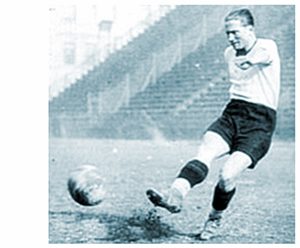
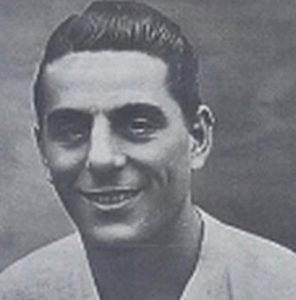
The first season is that of 1928-1929, Volk plays 30 games scoring 24 goals. There will be 5 occasions where he scores two goals in “le doppiette” match. In the penultimate week of the championship against Torino, which holds the first place in the classification, he even scores 5 goals (cinquina). These goals are often achieved with power, strong and accurate shots that keep his firm paid by the public “sciabbolone”. There are also those fans who call him that just to ironize the little brat Vittorio Emmanuele…but of course his name Volk is now Romanized in Vorke, as I mentioned above in the verses of the first hymn of Rome. Among other things, in this hymn that resembles a tango, Fulvio Bernardini is also mentioned “who gives school to the Argentines” (gives lectures, teaches the Argentines who were held as maestros for the time).
But who was Bernardini? Bernardini is one of the most important figures of the Roman club but also of Italian football. He will be one of the “emperors” of this club together with Amadeo Amadei, Paulo R. Falcao, Bruno Conti, Giuseppe Giannini and Francesco Totti. So Bernardini, in addition to his talent as a player, also had a wise head for the game of football and maybe even a generous heart in life, but we will talk about this quality a little later because precisely Bernardini and Volk will never forget each other.
Volk’s first Serie “A” championship ends with Rome ranked third. In five years, Rudolfo “sciabbolone” will play 557 games scoring 103 goals, among which is the first goal scored in the first official match against the Lazio team. Even for this fact, among others, his name is closely connected with the history of the Rome club and remains unforgettable in the statistics of this team. The newspaper “Il Corriere dello Sport” which at that time was called “Il Littoriale”, on the morning of December 9, 1929, will write:
“We learned that the majority of the city’s public was a fan of the “yellow-red” Roma. We believed that even blue colors had a wide support. We confirmed this after this derby. The decisive episode reaches the 20 minutes towards the end…..the ball reaches Volk who the audience was quoting loudly, “sciabbolone”, “sciabbolone”!!! Volk stood as usual with his back to the gate. He takes the ball and returns with an impressive and dizzying speed, releasing a ground shot and slamming the ball into the net. The goalkeeper of Lazio had made a desperate throw but was unable to stop the ball that rested at the bottom of the net. That’s how merciless judgment for the opponent had arrived from Volk’s leg”.
Arriving in the Roman capital on November 3, 1929, he scores the first goal with the jerseys of Rome in the mythical field called “Testaccio”. Hi also scored the first goal in the derby against Lazio on December 8, 1929 at the “La Rondinella” stadium. He is also the first “romanista” to win the title of “Best Scorer of the Championship” with 29 such goals in the 1930-1931 season, but he will also be remembered as the first player to surpass the 100 goal mark in Serie “A” championships. The first goal, in the first derby, in Rome’s first victory over Lazio. This is how Rudolfo Volk made the name “sciabbolone”, whose name was now cheered by the supporters of the colors “yellow and red”, the same colors that his first team “Unione Fiumiana” used to wear and with which he will return to play before Volk finally hung up his shoes.
However, the name will not guarantee him a future outside the football fields. World War II will involve everything and everyone and in these parts maybe more than anywhere else. Volk’s life, again in Fiume, as well as that of many people, will decline and deteriorate due to the transition of Istria to the part of the Federal Republic of Yugoslavia, which after 20 years had been part of Italy. At this point, the number of Italians born here must have been three hundred thousand, forced to leave their lands, seeing that people who did not want to know and did not take into account any reason had come to power. .
Always here in the hearth of the war, Tito’s partisans had “burned in the bin” every political enemy of theirs and unfortunately the Italians were the largest part of this category according to Tito’s criteria. Someone had even found physical elimination with a bullet in the head, but there were also those who were able to escape the shooting ……. with their hands still tied behind their backs.
Staying in these lands had become impossible. So even Rudolfo Volk, whose Fiumana shirt he didn’t have much to hang on to, give up everything and leaves.
In Fiume, he left his house, his bank account, his job at “Agip” and even his pension contributions. Together with his family, his wife and two children, he crosses the border that has been moved to the east, turning from a citizen to a refugee without thinking!!!
First stop in Goritzia, then Trieste and finally Udine. The consequences of a war have destroyed Italy and the misfortune of this population of Istria is that they become immigrants and foreigners in their Italy. All the other provinces and regions of Italy invited their compatriots to share together all the work and even the bread of the mouth even though it was a package. But the facts show that this will not happen.
However, Rudolfo Volk with 118 goals in the national championships with Rome, Fiorentina and Triestine, 5 appearances and 4 goals with the National team, ends up in a refugee camp in Laterina near Arezzo. Along with him is Alfio Mandic, a player in the “B” and “C” series who will issue this statement: “I arrived from Ancona at the Laterina railway station on August 19, 1948. An American military truck came to pick us up and dropped us off in front of the camp barracks. The surrounding area was completely isolated and there was no possibility of finding a job, even for the moment. The payment, or social assistance, was 105 lire per day, a miserable sum to cope with life. This is how the camp of Laterina appeared with its barracks outside the normal condition, with half-destroyed doors and windows and almost all of them to be repaired or replaced with new ones. To the right of the camp were four other barracks. One for kitchen and cooking, the others for primary and secondary schools and the library. The last one, the fourth one, was adopted into the Church. In this kind of camp without doors and without surrounding walls or fences, in the middle of a wide field of this village, without the possibility to find a job and secure a future, Rudolfo Volk spends almost 10 years of his life. Yes, yes, almost ten years of hard life for this champion, or better of a not human life at all.
All the attributes of this great pre-war champion, the name and nicknames “sciabbolone”, “er zigefrido”, his fame and successes come and go until they are completely forgotten in memory along with the lives of all those Italians from Istria in this camp .
But… But miraculously, someone had remembered the great name that Rudi Volk had “er zigefrido, Forke”. He was a former teammate at Roma and his friend Fulvio Bernardini. It’s the great Fulvio Bernardini who was quoted in the team’s anthem “who gives football lessons even to the masters of Argentina”. And so Bernardini goes to meet his friend “Forke”. It was about help, a decisive gesture, however, and a strong sign of friendship between them. Bernardini himself “broke the long silence” that had been created towards this wise and never complaining man, not even now that life had “turned his back”.
Volk was characterized as an extraordinary person and his only arrogance was the shots and goals scored once. The life of 105 lire in this camp was actually not “life”, but now Bernardini offers him a job as a keeper, not on the playing field where he often scored, nor on those broken doors of the camp barracks, but as a caretaker, keeper of the Palace of “Toto Calcio” of Rome in Pontevilio. This mythical man who was called “sciabbolone” in the stadium, who was condemned by life to have neither a past nor a future, from a center forward now became a “keeper”, but not one of those goalkeepers who bravely threw himself at the feet of the attackers. but from those janitors who scrub the floor keeping it clean from the people who pass there every day, even without drying well……..
Anyway, with that diligence and with that daily fatigue, Volk had finally returned to work and poured into his savings fund (even here at the end), pension contributions, since those from the time he worked for AGIP in Fiume in Istria were lost and would not be recognized as contributions, would not be taken into consideration from the post-war Italian state. Volk, it would never tell anyone this story even though it was part of his life, but in fact such events are part of the life of every person, part of our life.

Rarely had he taken the initiative to show any young man passionate about his sports past, his photos as a player on the field. And, Rudolfo “Volteni”, “sciabolone”, “zigefrido”, “Forke”, Volk at this point was limited to saying only this:
“Do you see this player in this photo? Once upon a time it was named after me”!
….not for nothing in Rome’s first football anthem it is quoted as follows:
“…we have the wizard Volk to score” / “cross the side, Volk shoots and net”!!!
By: Pjerin B.
The exclusivity on this page is dated December 28, 2022
________________
Sports Vision + / The Hour of The Champions in activity since 2013
Reference in building of this material: “Roma and its champions” / “Premium number. Story of Sport and dei Campioni”
Discover more from Sports Vision +
Subscribe to get the latest posts sent to your email.


